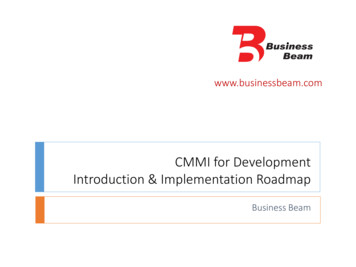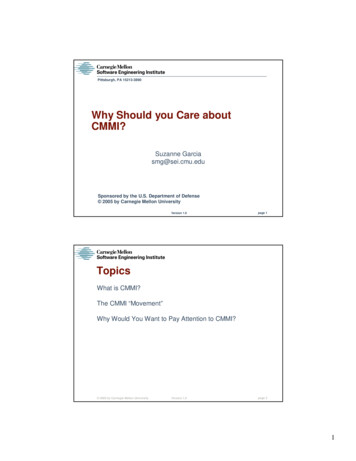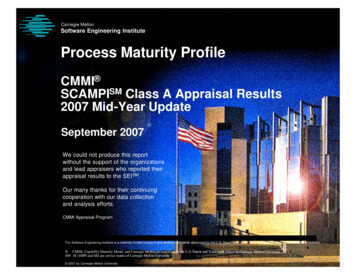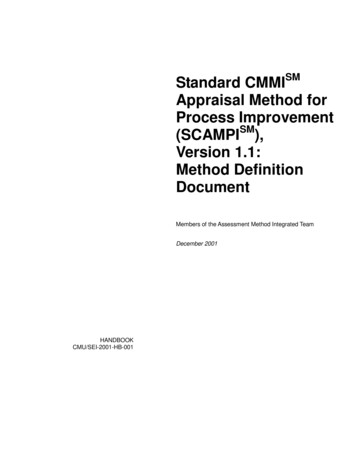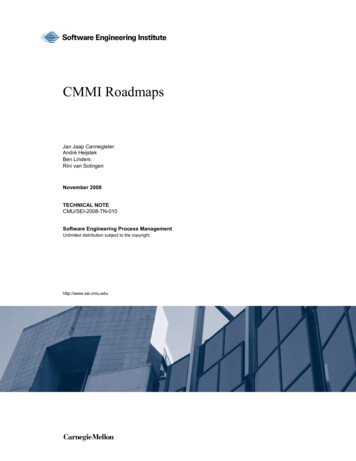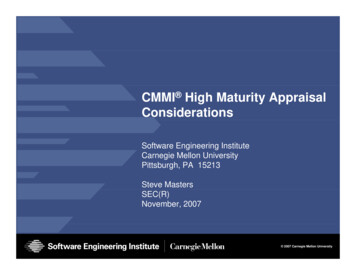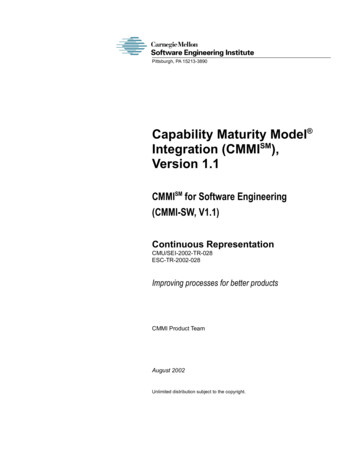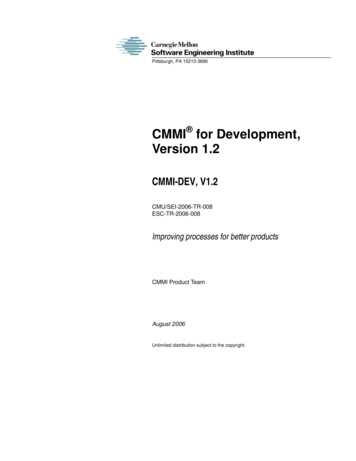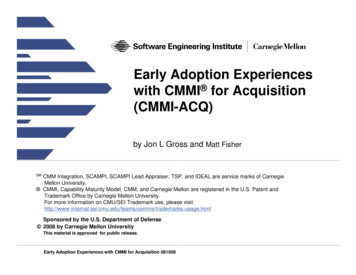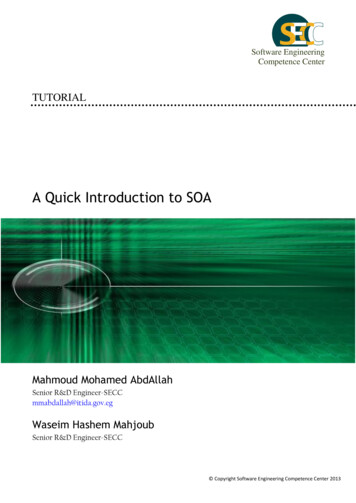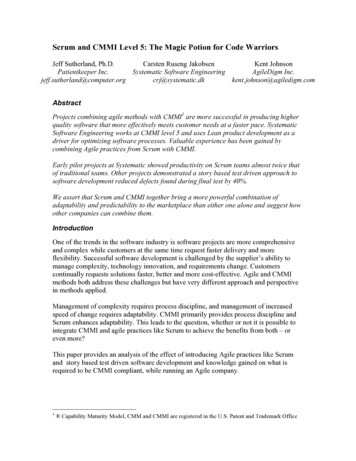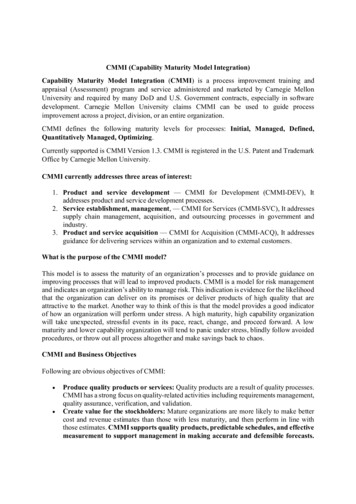
Transcription
CMMI (Capability Maturity Model Integration)Capability Maturity Model Integration (CMMI) is a process improvement training andappraisal (Assessment) program and service administered and marketed by Carnegie MellonUniversity and required by many DoD and U.S. Government contracts, especially in softwaredevelopment. Carnegie Mellon University claims CMMI can be used to guide processimprovement across a project, division, or an entire organization.CMMI defines the following maturity levels for processes: Initial, Managed, Defined,Quantitatively Managed, Optimizing.Currently supported is CMMI Version 1.3. CMMI is registered in the U.S. Patent and TrademarkOffice by Carnegie Mellon University.CMMI currently addresses three areas of interest:1. Product and service development — CMMI for Development (CMMI-DEV), Itaddresses product and service development processes.2. Service establishment, management, — CMMI for Services (CMMI-SVC), It addressessupply chain management, acquisition, and outsourcing processes in government andindustry.3. Product and service acquisition — CMMI for Acquisition (CMMI-ACQ), It addressesguidance for delivering services within an organization and to external customers.What is the purpose of the CMMI model?This model is to assess the maturity of an organization’s processes and to provide guidance onimproving processes that will lead to improved products. CMMI is a model for risk managementand indicates an organization’s ability to manage risk. This indication is evidence for the likelihoodthat the organization can deliver on its promises or deliver products of high quality that areattractive to the market. Another way to think of this is that the model provides a good indicatorof how an organization will perform under stress. A high maturity, high capability organizationwill take unexpected, stressful events in its pace, react, change, and proceed forward. A lowmaturity and lower capability organization will tend to panic under stress, blindly follow avoidedprocedures, or throw out all process altogether and make savings back to chaos.CMMI and Business ObjectivesFollowing are obvious objectives of CMMI: Produce quality products or services: Quality products are a result of quality processes.CMMI has a strong focus on quality-related activities including requirements management,quality assurance, verification, and validation.Create value for the stockholders: Mature organizations are more likely to make bettercost and revenue estimates than those with less maturity, and then perform in line withthose estimates. CMMI supports quality products, predictable schedules, and effectivemeasurement to support management in making accurate and defensible forecasts.
This process maturity can guard against project performance problems that could weakenthe value of the organization in the eyes of investors.Enhance customer satisfaction: Meeting cost and schedule targets with high-qualityproducts that are validated against customer needs is a good formula for customersatisfaction. CMMI addresses all of these ingredients through its emphasis on planning,monitoring, and measuring, and the improved predictability that comes with more capableprocesses.Increase market share: Market share is a result of many factors, including qualityproducts and services, name identification, pricing, and image. Customers like to deal withsuppliers who have a reputation for meeting their commitments.Gain an industry-wide recognition for excellence: The best way to develop a reputationfor excellence is to consistently perform well on projects, delivering quality products andservices within cost and schedule parameters. Having processes that conform to CMMIrequirements can enhance that reputation.CMMI RepresentationsThe fundamental building block of CMMI is a process area that defines goals and severalactivities that are often used to meet them. One example of a process area is Process and ProductQuality Assurance. Another is Configuration Management. It is important to understand that aprocess area is not a process. A single process may cross multiple process areas, and an individualprocess area may involve multiple processes.The CMMI-DEV is really two models that share the same underlying elements. The first and mostfamiliar is the Staged Representation, which presents the 22 process areas mapped into one offive organizational maturity levels. An appraisal of an organization would assess the level at whichit was operating, and this level would be an indicator of its ability to manage risk and, therefore,deliver on its promises. The staged representation is designed to provide a standard sequence ofimprovements, and can serve as a basis for comparing the maturity of different projects andorganizations. The staged representation also provides for an easy migration from the SW-CMMto CMMI.Levels 4 and 5 are often referred to as higher maturity levels. There is often a clear differencebetween higher maturity organizations, which exhibit the quantitative management and optimizing
behaviors, and lower maturity organizations, which are merely managed or following definedprocesses.Higher maturity organizations tend to be both more predictable and faster at responding to newinformation, assuming that other bureaucracy does not get in the way. Where low maturityorganizations tend to exhibit heroic effort, high maturity organizations may blindly followprocesses when under stress and fail to recognize that a process change may be a more appropriateresponse.The second, the Continuous Representation, models process capability within each of the 22process areas individually, allowing the organization to adapt their improvement efforts to theprocesses that offer the highest business value. The continuous representation is designed to allowthe user to focus on the specific processes that are considered important for the organization'simmediate business objectives, or those to which the organization assigns a high degree of risks.There are ways of mapping the results of a continuous model assessment into the five stages.Using the staged model as a basis for a process improvement program can be dangerous becauseimplementers may forget that the CMMI is not a process or workflow model but provides goalsfor process and workflow to achieve. Meeting those goals will improve the maturity of theorganization and the likelihood that events unfold as planned. Perhaps the biggest failuremode is making achieving a level the goal and then creating processes and infrastructuresimply to pass the appraisal. The goal of any process improvement activity should be measurableimprovement, not a number.The Continuous model seems to have some greater success as a guide to process improvement,and some consulting firms choose only to offer guidance around the Continuous model. The mostobvious difference is that a process improvement program that is designed around the Continuousmodel does not have artificial goals that are determined by maturity levels. The Continuous modelalso more naturally lends itself to applying process improvement in the areas where it is mostlikely to influence an economic benefit for the organization. Therefore, those who follow theContinuous model are more likely to receive positive feedback from an initiative that is based onthe CMMI model.
CMMI model with staged representationA maturity level is a well-defined evolutionary table toward achieving a mature software process.Each maturity level provides a layer in the foundation for continuous process improvement.In CMMI models with a staged representation, there are five maturity levels designated by thenumbers 1 through 51.2.3.4.5.InitialManagedDefinedQuantitatively ManagedOptimizingCMMI Staged Represenation- Maturity LevelsNow we will give more detail about each maturity level.Maturity Level Details:Maturity levels consist of a predefined set of process areas. The maturity levels are measured bythe achievement of the specific and generic goals that apply to each predefined set of processareas. The following sections describe the characteristics of each maturity level in detail.
Maturity Level 1 - InitialAt maturity level 1, processes are usually ad hoc and chaotic (disordered). The organization usuallydoes not provide a stable environment. Success in these organizations depends on the competenceand heroics of the people in the organization and not on the use of proven processes.Maturity level 1 organizations often produce products and services that work; however, theyfrequently exceed the budget and schedule of their projects.Maturity level 1 organizations are characterized by a tendency to over commit, abandon processesin the time of crisis, and not be able to repeat their past successes. Maturity Level 2 - ManagedAt maturity level 2, an organization has achieved all the specific and generic goals of the maturitylevel 2 process areas. In other words, the projects of the organization have ensured thatrequirements are managed and that processes are planned, performed, measured, and controlled.The process discipline reflected by maturity level 2 helps to ensure that existing practices areretained during times of stress. When these practices are in place, projects are performed andmanaged according to their documented plans.At maturity level 2, requirements, processes, work products, and services are managed. The statusof the work products and the delivery of services are visible to management at defined points.Commitments are established among relevant stakeholders and are revised as needed. Workproducts are reviewed with stakeholders and are controlled.The work products and services satisfy their specified requirements, standards, and objectives. Maturity Level 3 - DefinedAt maturity level 3, an organization has achieved all the specific and generic goals of the processareas assigned to maturity levels 2 and 3.At maturity level 3, processes are well characterized and understood, and are described instandards, procedures, tools, and methods.A critical distinction between maturity level 2 and maturity level 3 is the scope of standards,process descriptions, and procedures. At maturity level 2, the standards, process descriptions, andprocedures may be quite different in each specific instance of the process (for example, on aparticular project). At maturity level 3, the standards, process descriptions, and procedures for aproject are personalized from the organization's set of standard processes to suit a particular projector organizational unit. The organization's set of standard processes includes the processesaddressed at maturity level 2 and maturity level 3. As a result, the processes that are performedacross the organization are consistent except for the differences allowed by the tailoring guidelines.
Another critical distinction is that at maturity level 3, processes are typically described in moredetail and more rigorously than at maturity level 2. At maturity level 3, processes are managedmore proactively using an understanding of the interrelationships of the process activities anddetailed measures of the process, its work products, and its services. Maturity Level 4 - Quantitatively ManagedAt maturity level 4, an organization has achieved all the specific goals of the process areasassigned to maturity levels 2, 3, and 4 and the generic goals assigned to maturity levels 2 and 3.At maturity level 4 Subprocesses are selected that significantly contribute to overall processperformance. These selected subprocesses are controlled using statistical and other quantitativetechniques.Quantitative (measurable) objectives for quality and process performance are established andused as criteria in managing processes. Quantitative objectives are based on the needs of thecustomer, end users, organization, and process implementers. Quality and process performance areunderstood in statistical terms and are managed throughout the life of the processes.For these processes, detailed measures of process performance are collected and statisticallyanalyzed. Special causes of process variation are identified and, where appropriate, the sources ofspecial causes are corrected to prevent future occurrences.Quality and process performance measures are incorporated into the organizations measurementrepository to support fact-based decision making in the future.A critical distinction between maturity level 3 and maturity level 4 is the predictability of processperformance. At maturity level 4, the performance of processes is controlled using statistical andother quantitative techniques, and is quantitatively predictable. At maturity level 3, processes areonly qualitatively predictable. Maturity Level 5 - OptimizingAt maturity level 5, an organization has achieved all the specific goals of the process areasassigned to maturity levels 2, 3, 4, and 5 and the generic goals assigned to maturity levels 2 andlevel 3.Processes are continually improved based on a quantitative understanding of the common causesof variation inherent in processes.Maturity level 5 focuses on continually improving process performance through both incrementaland innovative technological improvements.Quantitative process-improvement objectives for the organization are established, continuallyrevised to reflect changing business objectives, and used as criteria in managing processimprovement.
The effects of deployed process improvements are measured and evaluated against the quantitativeprocess-improvement objectives. Both the defined processes and the organization's set of standardprocesses are targets of measurable improvement activities.Optimizing processes that are agile and innovative depends on the participation of an empoweredworkforce aligned with the business values and objectives of the organization. The organization'sability to rapidly respond to changes and opportunities is enhanced by finding ways to accelerateand share learning. Improvement of the processes is inherently part of everybody's role, resultingin a cycle of continual improvement.A critical distinction between maturity level 4 and maturity level 5 is the type of processvariation addressed. At maturity level 4, processes are concerned with addressing special causesof process variation and providing statistical predictability of the results. Though processes mayproduce predictable results, the results may be insufficient to achieve the established objectives.At maturity level 5, processes are concerned with addressing common causes of process variationand changing the process (that is, shifting the mean of the process performance) to improve processperformance (while maintaining statistical predictability) to achieve the established quantitativeprocess-improvement objectives.Maturity Levels Should Not be Skipped:Each maturity level provides a necessary foundation for effective implementation of processes atthe next level. Higher level processes have less chance of success without the discipline provided by lowerlevels.The effect of innovation can be obscured in a noisy process.Higher maturity level processes may be performed by organizations at lower maturity levels, withthe risk of not being consistently applied in a crisis.Maturity Levels and Process Areas:Here is a list of all the corresponding process areas defined for a S/W organization. These processareas may be different for different organization.
This section is just giving names of the related process y Process Area 3DefinedProcessStandardization ResultOrganizational InnovationHighestand Deployment/CausalAnalysisand QualityLowest eManagementProcessHigher/Project QualityLower RiskRequirements DevelopmentTechnical SolutionProduct IntegrationVerificationValidationOrganizational Process FocusOrganizationalProcessDefinitionOrganizational TrainingIntegrated Project Mgmt(with IPPD extras)Risk ManagementDecisionAnalysisandResolutionIntegrated Teaming (IPPDonly)Org.EnvironmentforIntegration (IPPD only)IntegratedSupplierManagement (SS only)MediumQualityMediumRisk/
2ManagedBasic ProjectManagement 1InitialProcessinformalAdhocisandRequirements ManagementProject PlanningProject Monitoring andControlSupplierAgreement Low Quality/ManagementHigh RiskMeasurement and AnalysisProcess and Product QualityAssuranceConfiguration ManagementLowestQuality/Highest RiskA capability level is a well-defined evolutionary plateau describing the organization's capabilityrelative to a process area. A capability level consists of related specific and generic practices for aprocess area that can improve the organization's processes associated with that process area. Eachlevel is a layer in the foundation for continuous process improvement.Thus, capability levels are cumulative, i.e., a higher capability level includes the attributes of thelower levels.
CMMI model with continuous representationIn CMMI models with a continuous representation, there are six capability levels designated bythe numbers 0 through 5. 0 - Incomplete1 - Performed2 - Managed3 - Defined4 - Quantitatively Managed5 - OptimizingA short description of each capability level is as follows:Capability Level 0: IncompleteAn "incomplete process" is a process that is either not performed or partially performed. One ormore of the specific goals of the process area are not satisfied and no generic goals exist for thislevel since there is no reason to institutionalize a partially performed process.This is equivalent to Maturity Level 1 in the staged representation.Capability Level 1: PerformedA Capability Level 1 process is a process that is expected to perform all of the Capability Level 1specific and generic practices. Performance may not be stable and may not meet specific objectivessuch as quality, cost, and schedule, but useful work can be done. This is only a start, or baby-step,in process improvement. It means that you are doing something but you cannot prove that it isreally working for you.Capability Level 2: ManagedA managed process is planned, performed, monitored, and controlled for individual projects,groups, or stand-alone processes to achieve a given purpose. Managing the process achieves boththe model objectives for the process as well as other objectives, such as cost, schedule, and quality.As the title of this level indicates, you are actively managing the way things are done in yourorganization. You have some metrics that are consistently collected and applied to yourmanagement approach.Remember: metrics are collected and used at all levels of the CMMI, in both the staged andcontinuous representations. It is a bitter fallacy to think that an organization can wait untilCapability Level 4 to use the metrics.
Capability Level 3: DefinedA capability level 3 process is characterized as a "defined process." A defined process is a managed(capability level 2) process that is tailored from the organization's set of standard processesaccording to the organization's tailoring guidelines, and contributes work products, measures, andother process-improvement information to the organizational process assets.Capability Level 4: Quantitatively ManagedA capability level 4 process is characterized as a "quantitatively managed process." Aquantitatively managed process is a defined (capability level 3) process that is controlled usingstatistical and other quantitative techniques. Quantitative objectives for quality and processperformance are established and used as criteria in managing the process. Quality and processperformance is understood in statistical terms and is managed throughout the life of the process.Capability Level 5: OptimizingAn optimizing process is a quantitatively managed process that is improved, based on anunderstanding of the common causes of process var
CMMI (Capability Maturity Model Integration) Capability Maturity Model Integration (CMMI) is a process improvement training and appraisal (Assessment) program and service administered and marketed by Carnegie Mellon University and required by many DoD and U.S. Government contracts, especially in software development.
